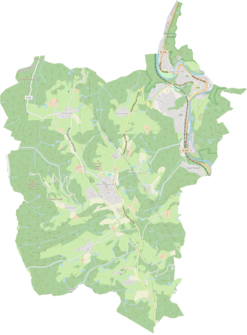Vossnocken
|
Vossnocken
Community Iserlohn
Coordinates: 51 ° 18 ′ 22 ″ N , 7 ° 37 ′ 36 ″ E
|
||
|---|---|---|
| Height : | 420 m | |
| Postal code : | 58769 | |
| Area code : | 02352 | |
|
Location of Vossnocken in Nachrodt-Wiblingwerde |
||
Vossnocken is a district of the municipality Nachrodt-Wiblingwerde in the Märkisches Kreis in the administrative district of Arnsberg in North Rhine-Westphalia ( Germany ).
Location and description
The living space is located southeast of the hill village of Wiblingwerde between the headwaters of the Hallenscheider Bach and the Düsternsiepen , which both drain into the Lenne via the Kreinberger Bach and Opperhusener Bach .
In addition to Wiblingwerde, neighboring locations are the locations and residential areas of Opperhusen , Eilerde , Helbecke , Stübbecken , Kreinberg , Buchholz , Eickhoff , Hallenscheid , Neuenhaus , Sassenscheid , Neusassenscheid , Waldemey and Lehmkuhle .
history
Vossnocken was first mentioned in 1733 as Fossnocken , the place name means Fuchshang . Other mentions are Vossnocken (1766), vosnacken (1767), vossnakken (1797) and from 1815 Vosnocken .
On the hand cracks (mensal sheets) for the map of the county of Mark von Eversmann , the place is labeled as Fosſnocken around 1795 . He is on the Prussian Uraufnahme of 1839 unmarked and from the Prussian new recording from 1892 on Ordnance Survey of TK25 as Voss cams (Issue 1892-94) and Voßnocken recorded.
Until the 19th century, Vossnocken belonged to the parish , office , recipe and district court of Altena in the county of Mark .
From 1816 the place was part of the school district Wiblingwerde of the tax community Wiblingwerde of the rural mayor's office Altena in the Altena district , in 1818 twelve residents lived in the place. The place categorized as Kotten according to the place and distance table of the government district Arnsberg had a house in 1839. At that time, twelve residents lived in the place, all of whom were evangelicals.
The municipality and estate district statistics of the province of Westphalia in 1871 list the place with two houses and 14 inhabitants. The municipality lexicon for the province of Westphalia in 1885 gives a number of 14 inhabitants for Vossnocken who lived in two houses. In 1895 the place had two houses with twelve inhabitants, in 1905 two houses and nine inhabitants are given.
On April 1, 1907, the municipalities of Wiblingwerde and Kelleramt were combined to form the municipality of Nachrodt-Wiblingwerde, making Vossnocken what is now the municipality.
Individual evidence
- ↑ a b Wilhelm Bleicher : On the interpretation of some place names in the community Nachrodt-Wiblingwerde . In: Altena. Contributions to local and regional studies . Heimatbund Märkischer Kreis, Nachrodt-Wiblingwerde 1984, p. 184-190 .
- ↑ a b Johann Georg von Viebahn : Local and distance table of the government district Arnsberg, arranged according to the existing state division, with details of the earlier areas and offices, the parish and school districts and topographical information. Ritter, Arnsberg 1841.
- ↑ Royal Statistical Bureau Prussia (ed.): The communities and manor districts of the Prussian state and their population . The Province of Westphalia, No. IX . Berlin 1874.
- ↑ Royal Statistical Bureau (Prussia) (ed.): Community encyclopedia for the province of Westphalia, based on the materials of the census of December 1, 1885 and other official sources, (community encyclopedia for the Kingdom of Prussia, Volume X), Berlin 1887.
- ↑ Königliches Statistisches Bureau (Prussia) (Ed.): Community encyclopedia for the province of Westphalia, based on the materials of the census of December 1, 1895 and other official sources, (community encyclopedia for the Kingdom of Prussia, Volume X), Berlin 1897.
- ↑ Königliches Statistisches Bureau (Prussia) (Ed.): Community encyclopedia for the province of Westphalia, based on the materials of the census of December 1, 1905 and other official sources, (community encyclopedia for the Kingdom of Prussia, Volume X), Berlin 1909.

